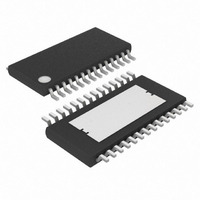MAX5051AUI+ Maxim Integrated Products, MAX5051AUI+ Datasheet - Page 12

MAX5051AUI+
Manufacturer Part Number
MAX5051AUI+
Description
IC PWR SPLY CNTRLR 28-TSSOP
Manufacturer
Maxim Integrated Products
Datasheet
1.MAX5051AUI.pdf
(21 pages)
Specifications of MAX5051AUI+
Pwm Type
Voltage Mode
Number Of Outputs
1
Frequency - Max
500kHz
Duty Cycle
48%
Voltage - Supply
11 V ~ 76 V
Buck
No
Boost
Yes
Flyback
Yes
Inverting
No
Doubler
No
Divider
No
Cuk
No
Isolated
Yes
Operating Temperature
-40°C ~ 125°C
Package / Case
28-TSSOP Exposed Pad, 28-eTSSOP, 28-HTSSOP
Frequency-max
500kHz
Lead Free Status / RoHS Status
Lead free / RoHS Compliant
The MAX5051 controller IC is designed for two-switch
forward converter power-supply topologies. It incorpo-
rates an advanced set of protection features that
makes it uniquely suitable when high reliability and
comprehensive fault protection are required, as in
power supplies intended for telecommunication
equipment. The device operates over a wide 11V to
76V supply range. By using the MAX5051 with a
secondary-side synchronous rectifier circuit, a very
efficient low output voltage and high output-current
power supply can be designed.
In a typical application, the AVIN pin is connected
directly to the input supply. The PVIN pin is connected
to the input supply through a bleed resistor. This is
used to charge up a reservoir capacitor. When the
voltage across this capacitor reaches approximately
24V, then primary switching commences. If the tertiary
winding is able to supply bias to the IC, then self
boot-strapping takes place and operation continues
normally. If the voltage across the reservoir capacitor
connected to PVIN falls below 6.2V, then switching
stops and the capacitor starts charging up again until
the voltage across it reaches 24V.
This device incorporates synchronization circuitry,
enabling the direct paralleling of two devices for higher
output power and lower input ripple current. Using a
single pin, the circuitry synchronizes and shifts the
phase of the second device by 180°. To enable simul-
taneous wakeup and shutdown, a STARTUP pin is pro-
vided. Connect all the STARTUP pins of all MAX5051
devices together to facilitate parallel operation in the
primary side. When each power supply generates dif-
ferent output voltages, connecting the STARTUP pins is
not necessary.
The two-switch forward-converter topology offers
outstanding robustness against faults and transformer
saturation while allowing the use of SO-8 power
MOSFETs with a voltage rating equal to only that of the
input supply voltage.
Voltage-mode control with feed-forward compensation
allows the rejection of input supply disturbances within
a single cycle, similar to that of current-mode controlled
topologies. This control method offers some significant
benefits not possible with current-mode control. These
benefits are:
• No minimum duty-cycle requirement because of cur-
Parallelable, Clamped Two-Switch
Power-Supply Controller IC
12
rent-signal blanking;
______________________________________________________________________________________
Detailed Description
Power Topology
• Clean modulator ramp and higher amplitude for
• Stable operating current of the optocoupler LED and
• Predictable loop dynamics simplifying the design of
The two-switch power topology has the added benefit
of recovering practically all magnetizing as well as the
leakage energy stored in the parasitics of the isolation
transformer. The lower clamped voltages on the prima-
ry power FETs allow for the use of low R
Figure 2 shows the schematic diagram of a 48V input
3.3V/10A output power supply built around the
MAX5051.
The MAX5051’s integrated high- and low-side MOSFET
drivers source and sink up to 2A of peak currents,
resulting in very low losses even when switching high
gate charge MOSFETs. The high-side gate driver
requires its own bypass capacitor connected between
BST and XFRMRH. Use high-quality ceramic capacitors
close to these two pins for bypass. Under normal oper-
ating conditions, the energy stored in the transformer
parasitics swings the XFRMRH pin to ground while the
transformer is resetting. During this time, the charge on
the boost capacitor connected to the BST pin is replen-
ished. However, under certain conditions, such as
when the magnetizing inductance of the transformer is
very high or when using conventional rectification at the
output, the duty cycle with light loads may become very
small. Thus, the energy stored could be insufficient to
swing XFRMRH to ground and replenish the boost
capacitor.
the magnetizing inductance reset interval, assuming
synchronous rectification where the output inductor is
not allowed to run discontinuous.
If the magnetizing inductance is kept below the follow-
ing minimum, then the boost capacitor charge will
not deplete:
where d is the duty cycle, V
the switching frequency, and Q
charge for the high-side MOSFET. The above formula is
only an approximation; the actual value will depend on
other parasitics as well.
increased stability;
phototransistor for maximized control-loop band-
width (in current-mode applications, the optocoupler
bias point is output-load dependent);
the control loop.
L
M
Figure
≤
0 294
.
3 shows the equivalent circuit during
d
2
f
s
2
Qg
IN
total
is the input voltage, f
gtotal
V
+
IN
MOSFET Drivers
( .
0 005
is the total gate
DS(ON)
A f
)
s
devices.
S
is












